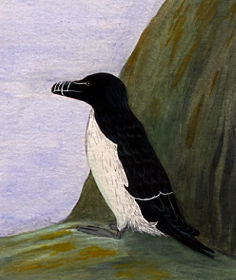Overview
 Order: Charadriiformes
Order: Charadriiformes
Family: Alcidae
Species: Alca torda
IUCN Status: Near Threatened
Population Trend: decreasing
Distribution: North Atlantic, breeding on coasts from western Greenland to New England (U.S.A.), Bear Island to Brittany. In winter, northern populations move south, some spreading into the Mediterranean as far as Italy. Present all year round in Britain.
Habitat: mainly coastal & offshore waters, breeding on sea cliffs etc.
Description: plumply built, penguin-like bird with black head & upperparts, white bar on hindwing, white underparts. Large, flattened black bill crossed with a line of white vertically across middle. Also white line from bill to near eye.
Size: 40cm (16in) in length.
Food: fish, crustaceans etc.
Razorbills belong to the auk family, along with guillemots and puffins. They look rather similar to guillemots but their dark feathers are black rather than chocolate brown, they are plumper and have thicker, heavier-looking bills. On the water, a razorbill floats higher than a guillemot and its longer tail tilts upwards.
The razorbill is well-named because the edges of its hooked upper beak are very sharp indeed, enabling it to grasp fish well and to defend itself against predators.
Read More: Feeding